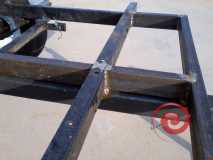48Rob wrote:Quite a few trailers in Europe have that same ungainly stance, where the wheels are pretty much in the middle of the body, leading to an unstable trailer if every last ounce of weight isn't in the exact correct spot.
It works...though many can't drive at a reasonable highway speed because they are so close to the edge (of being unstable).
Rob
Rob (
and all)-I hope I've not alienated anyone with the "cookie cutter" remark...it wasn't detrimental in any way, I just wanted to build a bolt together trailer with a sloped front end (in the wind shadow of the TV), and none of the plans I saw were exactly like that. Besides, I wanted a thick walled trailer, that could resist hail, branches, and road debris (the standard thin bent ply front made me wary). Just my preferences. But, as to "ungainly stance", maybe it is outside the norm, but was actually within the guidepoints
Angib posted in his Trailer Balance treatise:
Trailer Axle Position 'Rules of Thumb' Here are some really simple 'rules of thumb' that you can apply:
Axle Position, % of body length
(C/A in diagram above) Reasons to pick this value:
40% (eg, 38" from back for 8ft body)
A reasonable compromise value for an average teardrop.
45% (eg, 43" from back for 8ft body)
Tongue box.
Light or no galley.
Minimum safe hitch weight wanted.
35% (eg, 34" from back for 8ft body)
Well-equipped/heavy galley.
Long tongue.
Heavier hitch weight wanted.
Please remember that picking the right axle position does not mean that the trailer can be loaded without any thought - how it is loaded will determine the hitch weight, as much as where the axle is. I chose to replicate the middle road, as best I could
45% Always intended for a tongue box, a light galley (the original plan was for a counter space over the battery and generator, with no heavy cabinets > a weight trade-off). The galley ended up heavier than planned. A minimum safe hitch weight was intended (aimed for 100lbs/1000total, not attained!). The actual measurements were quite close to Andrew's 45%: 44.75" from hatch rear to wheel centerline, 53.75" from centerline to end of front wall (46% rear/54% front, but without tongue box or spare tire yet added forward) almost on the money. Using the calculations on the balance sheet, I thought I could use a toolbox instead of a tongue box, to save weight, but I'll have to move the battery forward as originally planned, and place it there. The pictures in my gallery do not give the true overall impression, and it does look a bit "ungainly". But on measurement, and with a few corrections, the 45% or better can be achieved. And, lest we forget, the tongue itself; it was intended to be longer than needed, heavier than needed, and stronger than needed. It was to lend itself to creating the balance desired. It is 42" from front of the trailer wall to the hitch ball, of 3"x.187" square tube, with an extra 2.5 feet under the front to tie in 3 crossmembers.

This was planned as a counter-balance for the extended rear ( I just over-loaded the rear). Once I rebalance the systems, I'll pull it out of the garage to get a full side-view and you'll see the balance of form. I also want to address the sway-bar issue: I've pulled trailers perfectly balanced, and some completely wrong, and traveled over smooth roads and those with dips and chugholes; I've found that using swaybars and/or weight-distributing hitches may be considered band-aids for some, but I've learned to never leave home without them. They turn marginal into manageable, and I never worry about the ball/coupler parting ways (happened to me once, bulldog coupler even!). The weight-distributing system was always part of my plan, the sway bar not so much. So the work goes on....If all corrections fail, then I'll eat crow, buy a 5x8 welded trailer, and unbolt the HHRv superstructure from the frame, and transfer the flag.











